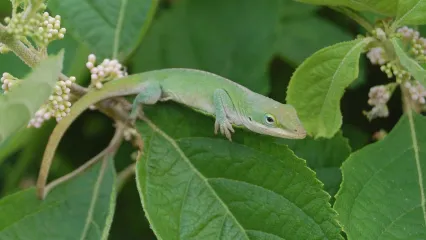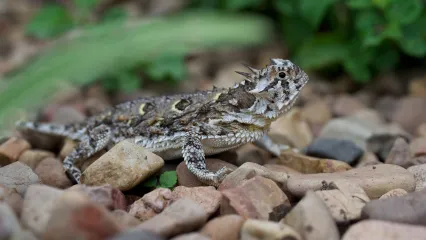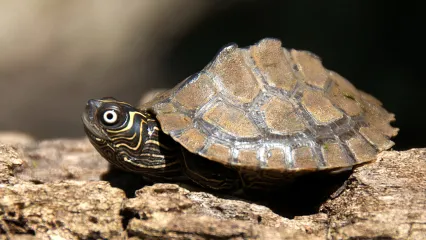
Description
The three-toed box turtle, a subspecies of eastern box turtle, is a relatively small terrestrial turtle with a high dome to the shell. Most individuals have a thin ridge on the centerline of the carapace. The plastron has anterior and posterior hinges and can close completely such that the entire body of the turtle is hidden. No webbing exists between toes, and the limbs are short. Adults are generally a uniform drab brown in coloration whereas juveniles often have light-colored (yellowish) spots near the center of each major scute on the carapace. However, some adults retain radiating light-colored lines on the carapace. The plastron is usually lighter in coloration and unmarked and is shorter than the carapace. Heads of adult males and females are often brightly colored with a combination of white, orange, or red. Males usually have red eyes whereas females usually have brown eyes. The three-toed box turtle may be confused with the plains box turtle, which is nearly identical in overall body form. The absence of radiating yellow lines on the plastron distinguishes the three-toed box turtle from the plains box turtles.
Size
Three-toed box turtles reach just over six and one-half inches in carapace length. Adult males are slightly smaller than adult females. Hatchlings are about one and one-half inches in carapace length.
Habitat
Three-toed box turtles occur in most of the eastern half of Oklahoma. Their distribution in the United States extends west to east from central Oklahoma up nearly the entire eastern seaboard. The distribution north to south extends from western Michigan to the tip of the Florida peninsula.
Life Cycle
Three-toed box turtles are strictly diurnal and are active from early spring (April) through late fall (October). They are often seen on paved highways just after dawn and late in the afternoon, particularly on wet or humid days. Three-toed box turtles eat a wide variety of food items, including insects, insect larvae, earthworms, carrion, fruits, and other vegetation. Apparently, as these turtles age, vegetation and fruits become more important in their diets compared with juveniles. Mating presumably occurs in spring, and because females are capable of storing sperm for several years, mating each year is not necessary for females to produce clutches of eggs. The number of eggs produced in individual clutches varies from 1–7 and females can produce up to six clutches in a single summer. Incubation takes two and one-half to three months. Three-toed box turtles reach sexual maturity at an age of 4–5 years and some individuals can live 70 years or more. Similar to most other turtle species, three-toed box turtles have a life history characterized by late maturity, long life, and repeated reproduction over a long female lifetime. As in other turtles, nest and juvenile mortality are probably high.
How To Observe
These common terrestrial turtles can easily be seen simply by driving roads in the morning during the spring or on wet days during summer. They are a bit more difficult to observe in forest because they remain still when approached and they blend in with leaf litter. Nevertheless, they are relatively easy to find, and by remaining still and waiting for five to ten minutes, it is possible to observe these turtles moving about. When picked up, these turtles usually close the shell completely and if set on the ground, often remain “boxed up” for an extended time period. When they finally open the shell, they usually look around and if they sense the presence of an observer, will not move.
(This profile was created by Dr. Laurie Vitt as part of a partnership between the Wildlife Department and the Sam Noble Oklahoma Museum of Natural History. It was funded as part of a larger State Wildlife Grant to survey and inventory amphibians and reptiles of the Wildlife Management Areas of Oklahoma: T-35-P-1.)


